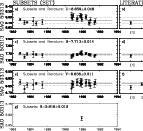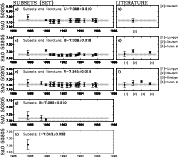The C2 of differential photometry is observed
to confirm the constant brightness of C1,
and to determine the brightness of C1.
Even for a C2 of unknown brightness,
the differential magnitudes
![]() can confirm
the short-term constant brightness of C1.
But this does not test the long-term constant brightness of C1.
For example, a low inclination late-type spotted
C1 with long-term variability might not exhibit short-term variability.
If the brightness of C2 is known,
the C1 brightness is obtained,
and the long-term constancy of C1 can eventually be
verified with respect to the other available data.
It is crucial for the long-term differential photometry of any variable star
(O) that the constant brightness of the chosen C1 and C2 combination
is confirmed with high accuracy.
Such a combination
should be consistently used in all subsequent differential photometry of O.
To achieve this goal, we compiled
numerous references of the UBVRI magnitudes (and errors)
for all C1 and C2 of V 1794 Cyg (Tables 1 and 2).
Furthermore, Table 2 contains new data
for the two most frequently used C1 (SAO 50313 and SAO 50205).
We will show that the best combination
for V 1794 Cyg would be C2=57 Cyg with C1=SAO 50313 or SAO 50205.
can confirm
the short-term constant brightness of C1.
But this does not test the long-term constant brightness of C1.
For example, a low inclination late-type spotted
C1 with long-term variability might not exhibit short-term variability.
If the brightness of C2 is known,
the C1 brightness is obtained,
and the long-term constancy of C1 can eventually be
verified with respect to the other available data.
It is crucial for the long-term differential photometry of any variable star
(O) that the constant brightness of the chosen C1 and C2 combination
is confirmed with high accuracy.
Such a combination
should be consistently used in all subsequent differential photometry of O.
To achieve this goal, we compiled
numerous references of the UBVRI magnitudes (and errors)
for all C1 and C2 of V 1794 Cyg (Tables 1 and 2).
Furthermore, Table 2 contains new data
for the two most frequently used C1 (SAO 50313 and SAO 50205).
We will show that the best combination
for V 1794 Cyg would be C2=57 Cyg with C1=SAO 50313 or SAO 50205.
Earlier C1 and C2 combinations for V 1794 Cyg appear arbitrary (see Table 3). The position of V 1794 Cyg in the vicinity of the North America Nebula (NGC 7000) and the Pelican Nebula (IC 5070) offers numerous C1 and C2 alternatives. Four secondary (16 Cyg B, 57 Cyg, SAO 50257, SAO 50326) and three primary comparison stars (SAO 50313, SAO 50205, SAO 50260) have been used. Furthermore, the primary comparison star SAO 50313 was once used as C2 (SET=38). The C2 of each SET is specified in Table 3 (Col. 5), where "Absolute'' denotes absolute photometry. No C2 was observed or specified during some subsets.
 |
Figure 1:
aceg)
The UBVR magnitudes of SAO 50313 during individual subsets
(Table 2:
|
 |
Figure 2: The UBVRI magnitudes of SAO 50205, otherwise as in Fig. 1 |
16 Cyg B (HD 186427, SAO 31899)
was used as a C2 only once (SET=28).
The long-term UBV are constant (Table 1),
but the RI show some scatter.
The Cousins RI by Rakos & Franz (1988)
transformed to the standard Johnson system (Bessell 1979)
agree with Moffett & Barnes (1979).
Thus the RI by Johnson et al. (1966) induce the large
errors of the long-term mean RI (Table 1).
16 Cyg B is a close "solar analog''-candidate
(Neckel 1986: G3V,
![]() ,
,
![]() ,
,
![]() ).
Since the upper limit of the solar luminosity variations
is
).
Since the upper limit of the solar luminosity variations
is
![]() (Willson & Hudson 1991),
detection of photometric variability
in this "solar analog''-candidate would be surprising.
16 Cyg B has been the standard star in many photometric studies
(e.g. Moffett & Barnes 1979; Skiff 1993).
The angular separation of
(Willson & Hudson 1991),
detection of photometric variability
in this "solar analog''-candidate would be surprising.
16 Cyg B has been the standard star in many photometric studies
(e.g. Moffett & Barnes 1979; Skiff 1993).
The angular separation of
![]() between
16 Cyg B and V 1794 Cyg requires a large extinction correction,
and thus it is an inconvenient C2 for differential photometry.
between
16 Cyg B and V 1794 Cyg requires a large extinction correction,
and thus it is an inconvenient C2 for differential photometry.
57 Cyg (HD 199081, SAO 50180,
![]() )
has been the most frequently used C2 for V 1794 Cyg.
The UBV measurements indicate constant long-term brightness.
But the RI have been measured only once
(Johnson et al. 1966).
57 Cyg is an early-type B5V spectroscopic binary
with
)
has been the most frequently used C2 for V 1794 Cyg.
The UBV measurements indicate constant long-term brightness.
But the RI have been measured only once
(Johnson et al. 1966).
57 Cyg is an early-type B5V spectroscopic binary
with
![]() ,
but not an eclipsing binary
(Hilditch 1973;
Batten et al. 1978;
Giuricin et al. 1984).
Since the masses are nearly equal
(
,
but not an eclipsing binary
(Hilditch 1973;
Batten et al. 1978;
Giuricin et al. 1984).
Since the masses are nearly equal
(
![]() ),
and the orbital inclination is
),
and the orbital inclination is
![]() ,
the upper limit for B changes is
,
the upper limit for B changes is
![]() (Hilditch 1973).
The differential UBVmagnitudes
(Hilditch 1973).
The differential UBVmagnitudes
![]() of our
APT photometry revealed no periodicity with
Porb,
nor any significant periodicity
between
of our
APT photometry revealed no periodicity with
Porb,
nor any significant periodicity
between
![]() and
50d.
Finally, we confirmed the
Porb for the
vraddata in Hilditch (1973).
That 57 Cyg was successfully used as C2
by Percy & Welch (1983)
in studying the low amplitude photometric variability in
early-type supergiants also supports short-term constant brightness.
Our APT differential UBV photometry of
SAO 50313 and SAO 50205 with respect to this C2confirmed constant short-term brightness.
Because the UBV magnitudes are accurate
and the RI magnitudes are available,
we conclude that 57 Cyg is
currently the best C2 choice for V 1794 Cyg.
Furthermore, 57 Cyg is the only
early-type C2 in Table 1,
all others being late-type stars with convective outer envelopes
possibly sustaining starspots.
and
50d.
Finally, we confirmed the
Porb for the
vraddata in Hilditch (1973).
That 57 Cyg was successfully used as C2
by Percy & Welch (1983)
in studying the low amplitude photometric variability in
early-type supergiants also supports short-term constant brightness.
Our APT differential UBV photometry of
SAO 50313 and SAO 50205 with respect to this C2confirmed constant short-term brightness.
Because the UBV magnitudes are accurate
and the RI magnitudes are available,
we conclude that 57 Cyg is
currently the best C2 choice for V 1794 Cyg.
Furthermore, 57 Cyg is the only
early-type C2 in Table 1,
all others being late-type stars with convective outer envelopes
possibly sustaining starspots.
SAO 50257 (HD 199512,
![]() )
is a K1-2 giant or subgiant
(Yoss 1961;
Straizys et al. 1989).
There are only two V measurements (Table 1).
The single B measurement is inaccurate (Turon et al. 1992),
but agrees with
)
is a K1-2 giant or subgiant
(Yoss 1961;
Straizys et al. 1989).
There are only two V measurements (Table 1).
The single B measurement is inaccurate (Turon et al. 1992),
but agrees with
![]() (Fehrenbach et al. 1987).
The short-term differential magnitudes SAO 50313 minus SAO 50257 were
constant (Bopp et al. 1983; Kaluzny 1984).
But SAO 50257 is an unsuitable C2,
because its long-term constant brightness is uncertain,
and the URI magnitudes unknown.
(Fehrenbach et al. 1987).
The short-term differential magnitudes SAO 50313 minus SAO 50257 were
constant (Bopp et al. 1983; Kaluzny 1984).
But SAO 50257 is an unsuitable C2,
because its long-term constant brightness is uncertain,
and the URI magnitudes unknown.
The spectral-type of SAO 50326 (HD 200060,
![]() )
is K2III
(McClure 1970;
Schmitt 1971;
Straizys et al. 1989).
The few UBV measurements reveal no
long-term variability (Table 1).
Heckert & Stewart (1992) detected no short-term
variability in the differential
UBV(RI)C magnitudes
SAO 50313 minus SAO 50326.
But this C2 is unsuitable, because its RI magnitudes are unknown.
)
is K2III
(McClure 1970;
Schmitt 1971;
Straizys et al. 1989).
The few UBV measurements reveal no
long-term variability (Table 1).
Heckert & Stewart (1992) detected no short-term
variability in the differential
UBV(RI)C magnitudes
SAO 50313 minus SAO 50326.
But this C2 is unsuitable, because its RI magnitudes are unknown.
Copyright The European Southern Observatory (ESO)